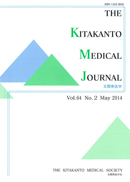Volume 64, Issue 2
Displaying 1-21 of 21 articles from this issue
- |<
- <
- 1
- >
- >|
ANNOUNCEMENT
-
2014Volume 64Issue 2 Pages 7A
Published: May 01, 2014
Released on J-STAGE: June 27, 2014
Download PDF (119K)
REVIEWS
-
2014Volume 64Issue 2 Pages 109-116
Published: May 01, 2014
Released on J-STAGE: June 27, 2014
Download PDF (1009K) -
2014Volume 64Issue 2 Pages 117-124
Published: May 01, 2014
Released on J-STAGE: June 27, 2014
Download PDF (1069K)
ORIGINALS
-
2014Volume 64Issue 2 Pages 125-134
Published: May 01, 2014
Released on J-STAGE: June 27, 2014
Download PDF (179K) -
2014Volume 64Issue 2 Pages 135-148
Published: May 01, 2014
Released on J-STAGE: June 27, 2014
Download PDF (384K)
CASE REPORTS
-
2014Volume 64Issue 2 Pages 149-152
Published: May 01, 2014
Released on J-STAGE: June 27, 2014
Download PDF (386K) -
2014Volume 64Issue 2 Pages 153-157
Published: May 01, 2014
Released on J-STAGE: June 27, 2014
Download PDF (573K) -
2014Volume 64Issue 2 Pages 159-163
Published: May 01, 2014
Released on J-STAGE: June 27, 2014
Download PDF (576K) -
2014Volume 64Issue 2 Pages 165-170
Published: May 01, 2014
Released on J-STAGE: June 27, 2014
Download PDF (1313K) -
2014Volume 64Issue 2 Pages 171-175
Published: May 01, 2014
Released on J-STAGE: June 27, 2014
Download PDF (557K) -
2014Volume 64Issue 2 Pages 177-182
Published: May 01, 2014
Released on J-STAGE: June 27, 2014
Download PDF (788K)
LETTER
-
2014Volume 64Issue 2 Pages 183-191
Published: May 01, 2014
Released on J-STAGE: June 27, 2014
Download PDF (2186K)
HOW TO DO IT
-
2014Volume 64Issue 2 Pages 193-196
Published: May 01, 2014
Released on J-STAGE: June 27, 2014
Download PDF (700K)
MATERIALS
-
2014Volume 64Issue 2 Pages 197-203
Published: May 01, 2014
Released on J-STAGE: June 27, 2014
Download PDF (359K) -
2014Volume 64Issue 2 Pages 205-213
Published: May 01, 2014
Released on J-STAGE: June 27, 2014
Download PDF (432K)
STREAM
-
2014Volume 64Issue 2 Pages 215-216
Published: May 01, 2014
Released on J-STAGE: June 27, 2014
Download PDF (289K) -
2014Volume 64Issue 2 Pages 217-218
Published: May 01, 2014
Released on J-STAGE: June 27, 2014
Download PDF (304K)
ABSTRACTS
-
2014Volume 64Issue 2 Pages 219-222
Published: May 01, 2014
Released on J-STAGE: June 27, 2014
Download PDF (373K) -
2014Volume 64Issue 2 Pages 223-231
Published: May 01, 2014
Released on J-STAGE: June 27, 2014
Download PDF (546K) -
2014Volume 64Issue 2 Pages 233-234
Published: May 01, 2014
Released on J-STAGE: June 27, 2014
Download PDF (264K)
EDITOR’S POSTSCRIPT
-
2014Volume 64Issue 2 Pages 235
Published: May 01, 2014
Released on J-STAGE: June 27, 2014
Download PDF (119K)
- |<
- <
- 1
- >
- >|
